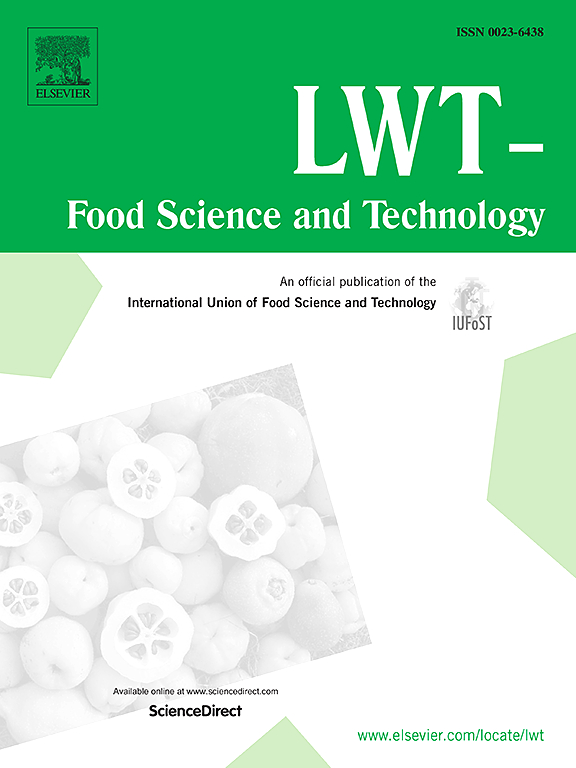纤维素纳米晶体/CaCO3纳米复合材料促进了皮克林乳液的制备:CaCO3在调整乳液行为和性能中的作用
IF 6
1区 农林科学
Q1 FOOD SCIENCE & TECHNOLOGY
引用次数: 0
摘要
纤维素纳米晶体(CNC)和CaCO3颗粒作为皮克林乳剂(PE)的稳定剂分别具有生物相容性和ph响应性,但乳化有限且释放突然。为了提高性能并实现控释,本研究引入了由CNC/CaCO3 (CNC/Ca)纳米复合材料稳定的Mosla chinensis精油(EO)负载PE,显示出优异的稳定性和ph响应性。表征结果(FT-IR、TG、XRD、XPS、三相接触角、AFM和TEM)表明,CaCO3调节了CNC的性能,包括电荷、热稳定性、结晶度、接触角、粗糙度、弹性模量和结构。CNC/Ca纳米复合材料提高了乳液的包封效率、粘度和长期稳定性,促进了颗粒网络的形成。CNC2/Ca2-PE的包封效率高达91.18%。除CNC1/Ca2-PE外,所有CNC/Ca-PE在120天内均表现出物理稳定性。体外释放和胃肠道模拟表明CNC/Ca-PE通过壳/网络破坏具有快速EO释放和ph控制行为。此外,CNC/Ca-PE对抗菌活性有积极的影响。这项研究强调了CNC/Ca纳米复合材料在设计高度稳定和可控的靶向给药PE系统方面的潜力。本文章由计算机程序翻译,如有差异,请以英文原文为准。
Cellulose nanocrystals/CaCO3 nanocomposites facilitated fabrication of Pickering emulsions: Role of CaCO3 in tailoring emulsion behaviors and performance
Cellulose nanocrystals (CNC) and CaCO3 particles are biocompatible and pH-responsive as stabilizers for Pickering emulsions (PE), respectively, yet with limited emulsification and abrupt release. To enhance performance and achieve controlled release, this study introduces Mosla chinensis essential oil (EO)-loaded PE stabilized by CNC/CaCO3 (CNC/Ca) nanocomposites, demonstrating superior stabilization and pH-responsiveness. Characterization results (FT-IR, TG, XRD, XPS, three-phase contact angle, AFM, and TEM) reveal that CaCO3 modulates CNC properties, including electric charge, thermal stability, crystallinity, contact angle, roughness, elastic modulus, and structure. The CNC/Ca nanocomposite improves encapsulation efficiency, viscosity, and long-term stability of the emulsion, fostering particle network formation. The encapsulation efficiency of CNC2/Ca2-PE was as high as 91.18%. Except for CNC1/Ca2-PE, all CNC/Ca-PE showed physical stability up to 120 days. In vitro release and gastrointestinal tract simulations show CNC/Ca-PE's rapid EO release and pH-controlled behavior through shell/network disruption. In addition, CNC/Ca-PE had a positive effect on antimicrobial activity. This research underscores the zeta potential of CNC/Ca nanocomposites in designing highly stable and controlled drug release PE systems for targeted delivery.
求助全文
通过发布文献求助,成功后即可免费获取论文全文。
去求助
来源期刊

LWT - Food Science and Technology
工程技术-食品科技
CiteScore
11.80
自引率
6.70%
发文量
1724
审稿时长
65 days
期刊介绍:
LWT - Food Science and Technology is an international journal that publishes innovative papers in the fields of food chemistry, biochemistry, microbiology, technology and nutrition. The work described should be innovative either in the approach or in the methods used. The significance of the results either for the science community or for the food industry must also be specified. Contributions written in English are welcomed in the form of review articles, short reviews, research papers, and research notes. Papers featuring animal trials and cell cultures are outside the scope of the journal and will not be considered for publication.
 求助内容:
求助内容: 应助结果提醒方式:
应助结果提醒方式:


